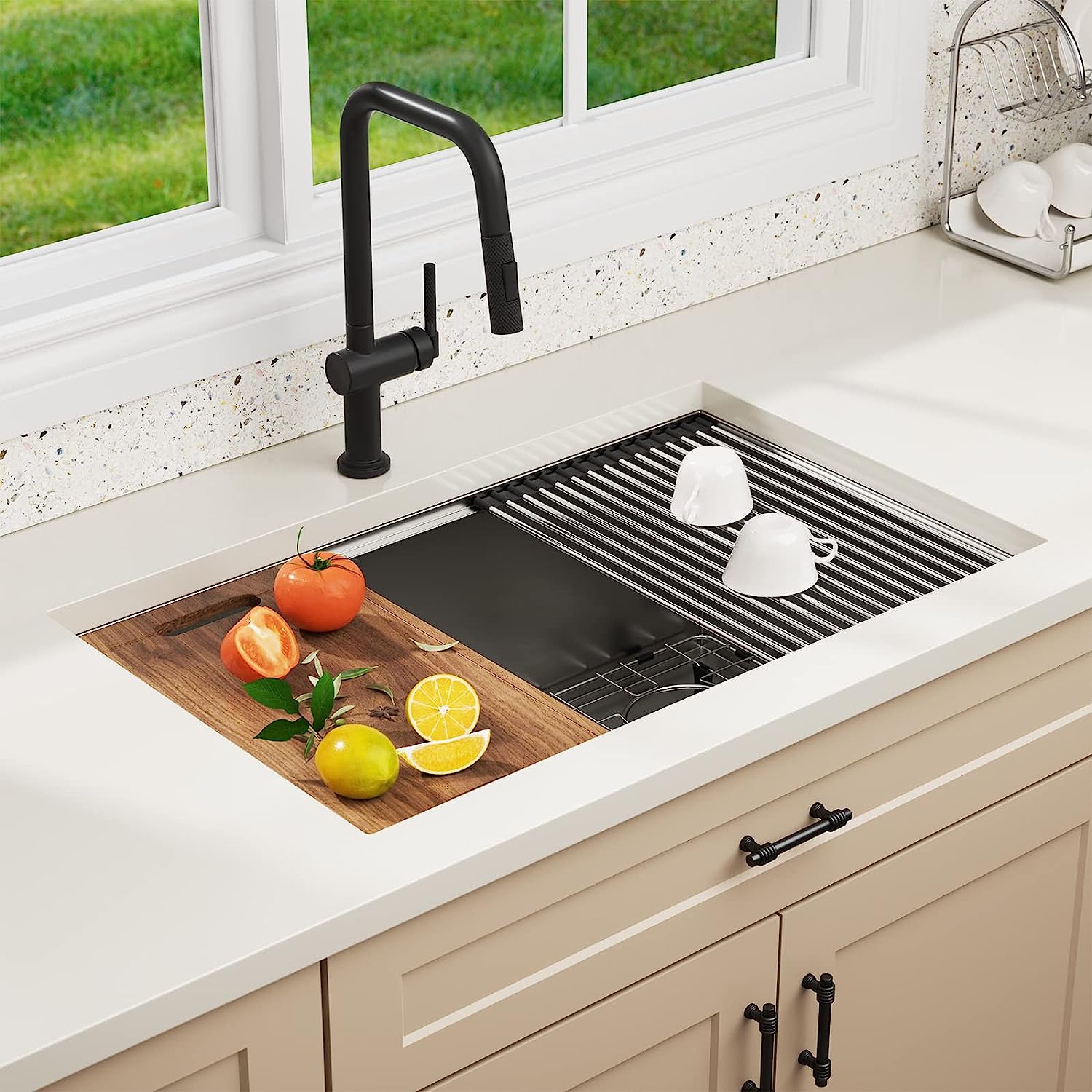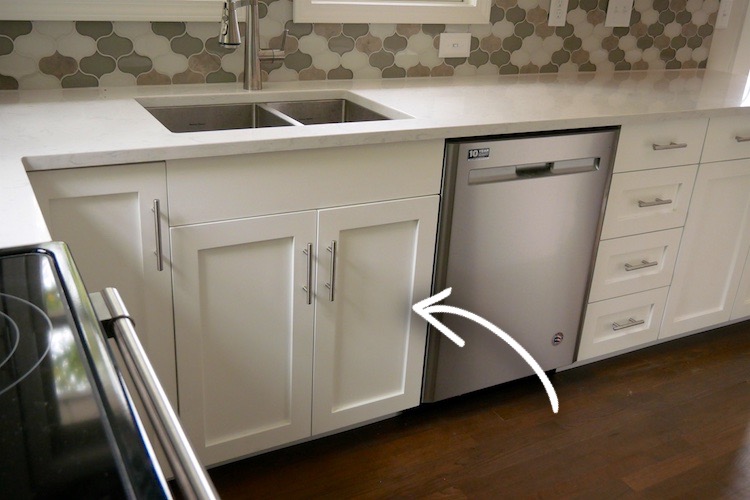Understanding Sink Size and Cabinet Dimensions

Choosing the right sink size for your kitchen is crucial for functionality and aesthetics. A 33-inch cabinet is a common size, but it’s important to consider the relationship between the sink’s dimensions and the cabinet width to ensure a perfect fit.
Countertop Overhang
Countertop overhang refers to the portion of the countertop that extends beyond the cabinet’s edge. It’s important to consider this overhang when selecting a sink for a 33-inch cabinet. If the sink is too large, it might create an excessive overhang, making it difficult to use the countertop space effectively. Conversely, if the sink is too small, it might leave an awkward gap between the sink and the countertop edge, which can be inconvenient and prone to water spills.
Common Sink Sizes for a 33-Inch Cabinet
Typical sink sizes that comfortably fit within a 33-inch cabinet range from 25 to 30 inches in width. This allows for a balanced countertop overhang without sacrificing usable space.
Sink Sizes and Cabinet Widths
Here’s a table showcasing common sink sizes and their corresponding cabinet widths:
| Sink Width (inches) | Cabinet Width (inches) | Countertop Overhang (inches) |
|---|---|---|
| 25 | 33 | 4 |
| 27 | 33 | 3 |
| 30 | 33 | 1.5 |
Exploring Different Sink Styles for a 33-Inch Cabinet: Sink Size For 33 Cabinet

Choosing the right sink style for your kitchen can be a real head-scratcher, especially when you’re working with a 33-inch cabinet. You’ve got to balance functionality with style, and that’s where things get tricky. But don’t worry, we’re here to help you navigate the sink stylescape!
We’ll dive into the pros and cons of different sink styles, like the classic single-bowl, the multitasking double-bowl, and the trendy farmhouse sink, all while keeping in mind the limitations of a 33-inch cabinet. We’ll also point out some popular sink brands that offer sizes perfect for this cabinet size.
Single-Bowl Sinks
Single-bowl sinks are a timeless choice for a reason – they’re simple, spacious, and easy to clean. In a 33-inch cabinet, you can fit a single-bowl sink with ample room to wash dishes, soak pots and pans, or even fill large containers.
Advantages
- Plenty of space for washing and soaking
- Easy to clean and maintain
- Versatile for different kitchen tasks
Disadvantages
- Limited functionality for multiple tasks at once
- Can be challenging to accommodate large items like baking sheets
Double-Bowl Sinks, Sink size for 33 cabinet
If you’re all about multitasking, a double-bowl sink might be your best bet. It’s like having two separate sinks, which is super handy for washing dishes in one bowl while rinsing produce in the other.
Advantages
- Offers greater functionality for simultaneous tasks
- Ideal for households with multiple cooks or frequent entertaining
- Provides dedicated space for different tasks
Disadvantages
- Each bowl may be smaller than a single-bowl sink
- Can be challenging to fit in a 33-inch cabinet, especially with larger bowls
- May require more counter space for drying dishes
Farmhouse Sinks
Farmhouse sinks, with their deep bowls and apron fronts, are a stylish and functional option that adds a touch of rustic charm to your kitchen. They’re often larger than traditional sinks, making them ideal for washing large items.
Advantages
- Spacious bowl for washing large items
- Adds a unique and stylish design element to your kitchen
- Provides extra counter space due to the apron front
Disadvantages
- Can be expensive compared to other sink styles
- May require special installation due to the apron front
- Can be challenging to fit in a 33-inch cabinet, especially with larger sizes
Recommended Sink Brands for a 33-Inch Cabinet
Here are a few popular sink brands that offer sizes suitable for a 33-inch cabinet:
- Kohler
- Blanco
- Elkay
- Rohl
- Kraus
Sink Style Comparison Table
| Sink Style | Recommended Cabinet Width | Features |
|---|---|---|
| Single-Bowl | 33 inches or larger | Spacious, easy to clean, versatile |
| Double-Bowl | 33 inches or larger (depending on bowl size) | Multitasking, dedicated space for different tasks |
| Farmhouse | 33 inches or larger (depending on size and apron front) | Stylish, deep bowl, extra counter space |
Practical Considerations for Sink Installation in a 33-Inch Cabinet

Installing a sink in a 33-inch cabinet involves careful planning to ensure proper fit, functionality, and aesthetics. This section will guide you through the practical considerations to make the process smooth and successful.
Measuring the Cabinet Opening and Selecting the Appropriate Sink Size
The first step is to accurately measure the cabinet opening to determine the ideal sink size. This ensures the sink fits comfortably within the cabinet, leaving sufficient space for plumbing and countertop overhang. Measure the width, depth, and height of the cabinet opening, taking into account any obstructions like cabinet framing or plumbing pipes.
- Width: Measure the widest point of the cabinet opening. This will be the maximum width of the sink you can install.
- Depth: Measure the depth of the cabinet opening, taking into account any existing countertop overhang. This measurement will determine the maximum depth of the sink you can choose.
- Height: Measure the height of the cabinet opening, considering any existing countertop thickness. This measurement will influence the height of the sink bowl and the overall sink profile.
Once you have these measurements, you can start exploring sink options that fit within these dimensions. Remember to factor in the size of the faucet, as it will take up additional space on the countertop.
Ensuring Proper Drainage and Plumbing for a Sink in a 33-Inch Cabinet
Proper drainage is crucial for a functional sink. When installing a sink in a 33-inch cabinet, consider the following factors to ensure effective drainage:
- Drain Placement: The drain opening should be positioned in the center of the sink bowl to prevent water from pooling on one side. This also helps maintain a balanced water flow for optimal drainage.
- Drainpipe Size: The drainpipe connecting the sink to the main plumbing should be sufficiently large to handle the water flow. A 1 1/2-inch diameter drainpipe is typically recommended for most kitchen sinks.
- P-Trap: The P-trap, which prevents sewer gases from entering the house, should be installed correctly to ensure smooth drainage. Make sure the P-trap is properly vented to avoid clogs and ensure efficient water flow.
- Vent Pipe: A vent pipe is essential for proper drainage, especially in a 33-inch cabinet where space is limited. The vent pipe allows air to enter the drain system, preventing suction and ensuring smooth water flow.
It’s advisable to consult a plumber for guidance on installing the drainage system, as they can ensure it meets local plumbing codes and regulations.
Impact of Faucet Design on Sink Size and Cabinet Width
The faucet you choose plays a significant role in determining the overall sink size and cabinet width required.
- Faucet Style: A single-hole faucet requires a sink with a single hole for installation. A widespread faucet requires three holes for installation, typically spaced 8 inches apart. A bridge faucet requires two holes for installation, with the spout spanning the gap between the holes.
- Spout Reach: The reach of the faucet spout, which is the distance from the faucet base to the end of the spout, influences the sink size required. A longer spout may require a wider sink to prevent it from hitting the cabinet or countertop.
- Handle Placement: The placement of the faucet handles can also impact the sink size. Handles on the side of the faucet may require a slightly wider sink to accommodate their placement.
Consider the faucet design and its impact on sink size and cabinet width before making your final selections.
Tips for Maximizing Space and Functionality Within a 33-Inch Cabinet with a Sink
Maximizing space and functionality within a 33-inch cabinet with a sink is crucial for creating a well-organized and efficient workspace. Here are some tips to achieve this:
- Compact Sink Design: Choose a compact sink design that fits within the cabinet opening while providing sufficient space for washing and rinsing dishes. Consider a single-bowl sink or a smaller double-bowl sink.
- Undermount Sink: An undermount sink, which is installed beneath the countertop, provides a seamless and clean look, maximizing countertop space. This option also allows for easy cleaning of the countertop around the sink.
- Slim Faucet Design: Select a slim faucet design that doesn’t take up too much space on the countertop. Consider a single-handle faucet or a bridge faucet with a slim spout.
- Vertical Storage: Utilize vertical storage solutions, such as a pull-out drawer or a tiered storage system, to maximize the space beneath the sink. This helps keep cleaning supplies, dish soap, and other items organized and easily accessible.
By implementing these tips, you can create a functional and efficient workspace within a 33-inch cabinet with a sink.
Sink size for 33 cabinet – Choosing the right sink size for a 33″ cabinet is a balancing act between functionality and aesthetics. You want a sink that’s large enough for your needs, but not so big that it overwhelms the space. If you’re struggling to keep your upstairs bedroom cool, consider checking out this helpful guide on how to cool down upstairs bedroom – you might find some valuable tips to make your home more comfortable.
Once you’ve tackled the heat, you can return to the sink size dilemma with a clear head and a cool demeanor!
Choosing the right sink size for a 33-inch cabinet is a crucial step in any kitchen renovation, especially in a compact space like a one bedroom apartment in Leeds city centre. Maximizing functionality within limited square footage is key, and a well-chosen sink can make a significant difference in the overall usability of your kitchen.